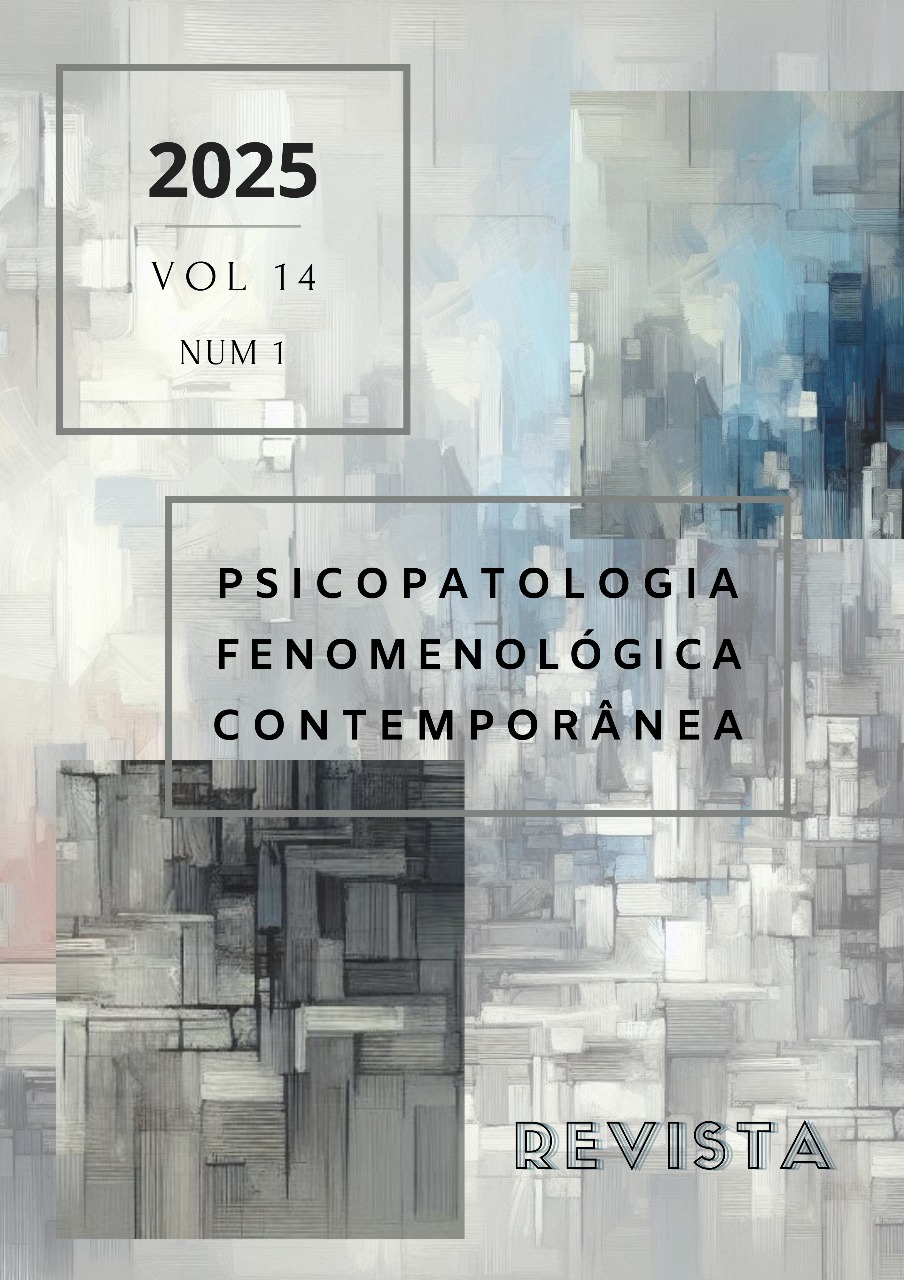Autism in adults
life experiences after a late diagnosis
DOI:
https://doi.org/10.37067/rpfc.v14i1.1235Palavras-chave:
Adult autism, Life experience, Difficulties, FacilitiesResumo
Previously considered a rare childhood disorder, autism today is a frequent diagnosis with increasing demand in all age groups, including people who were not diagnosed in childhood, but who perceive characteristics of this condition. This study, which is part of a broader research on the experience of Brazilian adults who were diagnosed with autism spectrum disorder (ASD) after 18 years, aims to explore the life stories, present and past, of this group of people. To this end, a qualitative research was carried out in which 12 participants were interviewed and the data were analyzed using the content analysis method, in its categorical aspect. Considering the objective of this work, in the analysis of the interviews, these categories emerged: social difficulty as the central point, sensory issues, language difficulties and naivety, rigidity/repetitive behavior, and facilities/advantages that autism brought. It was observed that social difficulties remained a central issue, even in a group of adults with mild autism, as well as sensory complaints, difficulty understanding figurative language and rigidity. Attentional hyperfocus is cited as something positive, that brings facilities to everyday life. It was concluded that the characteristics described above are present in the lives of this group of autistic people, with significant disadvantage to their daily lives.
Downloads
Métricas
Referências
Amato, C. A. H. (2022) Aspectos pragmáticos no TEA. In A. C. Tamanaha, C. C. Ribeiro, C. S. Azoni, J.O. Lira (Org.), Estudos de linguagem no transtorno do espectro do autismo. – São Paulo, SP: ABarros.
American Psychiatric Association (1994). Manual de Diagnóstico e Estatística de Distúrbios Mentais DSM-IV. São Paulo: Manole,
American Psychiatric Association. (2013). Diagnostic and statistical manual of mental disorders (5th ed.). American Psychiatric Association. Ausderau, K., Sideri DOI: https://doi.org/10.1176/appi.books.9780890425596
Anderson, C., & Butt, C. (2018). Young Adults on the Autism Spectrum: The Struggle for Appropriate Services. Journal of autism and developmental disorders, 48(11), 3912–3925. https://doi.org/10.1007/s10803-018-3673-z DOI: https://doi.org/10.1007/s10803-018-3673-z
Ashinoff, B.K., & Abu-Akel. (2021). A. Hyperfocus: the forgotten frontier of attention. Psychological Research 85, 1–19 https://doi.org/10.1007/s00426-019-01245-8 DOI: https://doi.org/10.1007/s00426-019-01245-8
Attwood. T. & Gray, C. (1999), The Discovery of "Aspie" Criteria, The Morning News. Volume 11, Number 3.
Bardin, L. (2016). Análise de conteúdo. Lisboa: Edições 70.
Booth T, Murray AL, McKenzie K, Kuenssberg R, O’Donnell M, Burnett H. (2013). Brief report: an evaluation of the AQ-10 as a brief screening instrument for ASD in adults. J Autism Dev Disord; 43: 2997–3000. DOI: https://doi.org/10.1007/s10803-013-1844-5
Bottema-Beutel, K., Kapp, S. K., Lester, J. N., Sasson, N. J., & Hand, B. N. (2021). Avoiding Ableist Language: Suggestions for Autism Researchers. Autism in adulthood : challenges and management, 3(1), 18–29. https://doi.org/10.1089/aut.2020.0014 DOI: https://doi.org/10.1089/aut.2020.0014
Buck, T. R., Viskochil, J., Farley, M., Coon, H., McMahon, W. M., Morgan, J., & Bilder, D. A. (2014). Psychiatric comorbidity and medication use in adults with autism spectrum disorder. Journal of autism and developmental disorders, 44(12), 3063–3071. https://doi.org/10.1007/s10803-014-2170-2 DOI: https://doi.org/10.1007/s10803-014-2170-2
Chou, W. J., Wang, P. W., Hsiao, R. C., Hu, H. F., & Yen, C. F. (2020). Role of School Bullying Involvement in Depression, Anxiety, Suicidality, and Low Self-Esteem Among Adolescents With High-Functioning Autism Spectrum Disorder. Frontiers in psychiatry, 11, 9. https://doi.org/10.3389/fpsyt.2020.00009 DOI: https://doi.org/10.3389/fpsyt.2020.00009
Crane, L., Adams, F., Harper, G., Welch, J., & Pellicano, E. (2019). 'Something needs to change': Mental health experiences of young autistic adults in England. Autism : the international journal of research and practice, 23(2), 477–493. https://doi.org/10.1177/1362361318757048 DOI: https://doi.org/10.1177/1362361318757048
Crane, L., Goddard, L., & Pring, L. (2009). Sensory processing in adults with autism spectrum disorders. Autism, 13(3), 215-228. https://doi.org/10.1177/1362361309103794 DOI: https://doi.org/10.1177/1362361309103794
Csikszentmihalyi, M. (1975). Beyond Boredom and Anxiety. Washington: Jossey-Bass Publishers
Damasio, A. & Maurer, R. (1978), A neurological model for childhood autism. Arch. Neurol., 35:777-786. DOI: https://doi.org/10.1001/archneur.1978.00500360001001
DePape, A.-M., & Lindsay, S. (2016). Lived Experiences From the Perspective of Individuals With Autism Spectrum Disorder: A Qualitative Meta-Synthesis. Focus on Autism and Other Developmental Disabilities, 31(1), 60-71. https://doi.org/10.1177/1088357615587504 DOI: https://doi.org/10.1177/1088357615587504
Dietz P. M., Rose, C. E., McArthur, D., & Maenner, M. (2020). National and State Estimates of Adults with Autism Spectrum Disorder. Journal of autism and developmental disorders, 50(12), 4258–4266. https://doi.org/10.1007/s10803-020-04494-4 DOI: https://doi.org/10.1007/s10803-020-04494-4
Fein, D., Pennington, B., Markowitz, P., Braverman, M., & Waterhouse, L. (1986). Toward a neuropsychological model of infantile autism: Are the social deficits primary? Journal of the American Academy of Child and Adolescent Psychiatry, 25 198–212. DOI: https://doi.org/10.1016/S0002-7138(09)60227-2
Grandin, T (2010, February) The world needs all kinds of minds [Video]. TED Conferences https://www.ted.com/talks/temple_grandin_the_world_needs_all_kinds_of_minds?utm_campaign=tedspread&utm_medium=referral&utm_source=tedcomshare
Grandin, T. (2020). Different-- not less: inspiring stories of achievement and successful employment from adults with autism, Asperger's, and ADHD. Arlington, TX, Future Horizons Inc.
Handen, B. L., Mazefsky, C. A., Gabriels, R. L., Pedersen, K. A., Wallace, M., Siegel, M., & Autism and Developmental Disorders Inpatient Research Collaborative (ADDIRC) (2018). Risk Factors for Self-injurious Behavior in an Inpatient Psychiatric Sample of Children with Autism Spectrum Disorder: A Naturalistic Observation Study. Journal of autism and developmental disorders, 48(11), 3678–3688. https://doi.org/10.1007/s10803-017-3460-2 DOI: https://doi.org/10.1007/s10803-017-3460-2
Happé, F. (2015). Autism as a neurodevelopmental disorder of mind-reading. Journal of the British Academy, 3, 197–209. DOI 10.5871/jba/003.197 DOI: https://doi.org/10.5871/jba/003.197
Hollocks, M. J., Lerh, J. W., Magiati, I., Meiser-Stedman, R., & Brugha, T. S. (2019). Anxiety and depression in adults with autism spectrum disorder: A systematic review and meta-analysis. Psychological medicine, 49(4), 559-572. DOI: https://doi.org/10.1017/S0033291718002283
Howlin, P., & Moss, P. (2012). Adults with autism spectrum disorders. Canadian journal of psychiatry. Revue canadienne de psychiatrie, 57(5), 275–283. https://doi.org/10.1177/070674371205700502 DOI: https://doi.org/10.1177/070674371205700502
Kanner, L. (1943). Autistic disturbances of affective contact. Nervous Child, 2, 217–250
Kirby, A. V., Bilder, D. A., Wiggins, L. D., Hughes, M. M., Davis, J., Hall-Lande, J. A., Lee, L.-C., McMahon, W. M., & Bakian, A. V. (2022). Sensory features in autism: Findings from a large population-based surveillance system. Autism Research, 15(4), 751–760. https://doi.org/10.1002/aur.2670 DOI: https://doi.org/10.1002/aur.2670
Lai, M.-C., & Baron-Cohen, S. (2015). Identifying the lost generation of adults with autism spectrum conditions. The Lancet. Psychiatry, 2(11), 1013–1027. https://doi.org/10.1016/S2215-0366(15)00277-1 DOI: https://doi.org/10.1016/S2215-0366(15)00277-1
Lai, M. C., Kassee, C., Besney, R., Bonato, S., Hull, L., Mandy, W., Szatmari, P., & Ameis, S. H. (2019). Prevalence of co-occurring mental health diagnoses in the autism population: a systematic review and meta-analysis. The lancet. Psychiatry, 6(10), 819–829. https://doi.org/10.1016/S2215-0366(19)30289-5 DOI: https://doi.org/10.1016/S2215-0366(19)30289-5
Leedham, A., Thompson, A. R., Smith, R., & Freeth, M. (2020). ‘I was exhausted trying to figure it out’: The experiences of females receiving an autism diagnosis in middle to late adulthood. Autism, 24(1), 135-146. https://doi.org/10.1177/1362361319853442 DOI: https://doi.org/10.1177/1362361319853442
Lord, C., Risi, S., Lambrecht, L., Cook, E. H., Jr, Leventhal, B. L., DiLavore, P. C., Pickles, A., & Rutter, M. (2000). The autism diagnostic observation schedule-generic: a standard measure of social and communication deficits associated with the spectrum of autism. Journal of autism and developmental disorders, 30(3), 205–223. DOI: https://doi.org/10.1023/A:1005592401947
Lovaas, O. I., Schreibman, L., Koegel, R., & Rehm, R. (1971). Selective responding by autistic children to multiple sensory input. Journal of Abnormal Psychology, 77(3), 211–222. https://doi.org/10.1037/h0031015 DOI: https://doi.org/10.1037/h0031015
Mandell, D. S., Novak, M. M., & Zubritsky, C. D. (2005). Factors associated with age of diagnosis among children with autism spectrum disorders. Pediatrics, 116(6), 1480–1486. https://doi.org/10.1542/peds.2005-0185 DOI: https://doi.org/10.1542/peds.2005-0185
Martínez-González, A. E., Cervin, M., & Piqueras, J. A. (2022). Relationships Between Emotion Regulation, Social Communication and Repetitive Behaviors in Autism Spectrum Disorder. Journal of autism and developmental disorders, 52(10), 4519–4527. https://doi.org/10.1007/s10803-021-05340-x DOI: https://doi.org/10.1007/s10803-021-05340-x
McDonnell, Andy & Milton, Damian (2014) Going with the flow: reconsidering ‘repetitive behaviour’ through the concept of ‘flow states’. In: Jones, Glenys and Hurley, Elizabeth, eds. Good Autism Practice: autism, happiness and wellbeing. BILD, Birmingham, UK, pp. 38-47. ISBN 978-1-905218-35-6.
Mousinho, R., Schmid, E., Mesquita, F. & Pereira, J.(2021). Estratégias lingüísticas para crianças e adolescentes TEA no ensino fundamental e médio. In M. Soares & R. Mousinho. Tenho um aluno autista: e agora?, 133 – 151, Artesã. National Institute for Health and Clinical Excellence (2012). Autism: recognition, referral, diagnosis and management of adults on the autism spectrum, Vol 142. London: National Institute for Health and Clinical Excellence.
O'Neill, M., & Jones, R. S. (1997). Sensory-perceptual abnormalities in autism: a case for more research?. Journal of autism and developmental disorders, 27(3), 283–293. https://doi.org/10.1023/a:1025850431170 DOI: https://doi.org/10.1023/A:1025850431170
Park, I., Gong, J., Lyons, G.L., Hirota, T., Takahashi, M., Kim, B., Lee, S.Y., Kim, Y.S., Lee, J., & Leventhal, B.L. (2020). Prevalence of and Factors Associated with School Bullying in Students with Autism Spectrum Disorder: A Cross-Cultural Meta-Analysis. Yonsei Medical Journal, 61, 909 - 922. DOI: https://doi.org/10.3349/ymj.2020.61.11.909
Rapaport, H., Clapham, H., Adams,J., Lawson, W., Porayska-Pomsta, K., and Pellicano,E. (2023).“In a State of Flow”: A Qualitative Examination of Autistic Adults' Phenomenological Experiences of Task Immersion. Autism in Adulthood - Online ahead of print December 20, 2023 http://doi.org/10.1089/aut.2023.0032 DOI: https://doi.org/10.1089/aut.2023.0032
Robertson, C. E., & Baron-Cohen, S. (2017). Sensory perception in autism. Nature reviews. Neuroscience, 18(11), 671–684. https://doi.org/10.1038/nrn.2017.112 DOI: https://doi.org/10.1038/nrn.2017.112
Russell, A. J., Mataix-Cols, D., Anson, M., & Murphy, D. G. (2005). Obsessions and compulsions in Asperger syndrome and high-functioning autism. The British journal of psychiatry : the journal of mental science, 186, 525–528. https://doi.org/10.1192/bjp.186.6.525 DOI: https://doi.org/10.1192/bjp.186.6.525
Russell, G., Kapp, S. K., Elliott, D., Elphick, C., Gwernan-Jones, R., & Owens, C. (2019). Mapping the Autistic Advantage from the Accounts of Adults Diagnosed with Autism: A Qualitative Study. Autism in adulthood : challenges and management, 1(2), 124–133. https://doi10.1089/aut.2018.0035 DOI: https://doi.org/10.1089/aut.2018.0035
Rutter, M. (I983). Cognitive deficits in the pathogenesis of autism. J. Child Psychol. Psvchiat., 24:513-531. DOI: https://doi.org/10.1111/j.1469-7610.1983.tb00129.x
Sacks, O. (1995). Um Antropólogo em Marte: Sete histórias paradoxais, 297-331, São Paulo: Companhia das letras, 1995.
Sinclair J. (2013) Why I Dislike ‘‘Person First’’ Language. Autonomy, The Critical Journal of Interdisciplinary Autism Studies , 1(2).
Tavassoli, T., Miller, L. J., Schoen, S. A., Nielsen, D. M., & Baron-Cohen, S. (2014). Sensory over-responsivity in adults with autism spectrum conditions. Autism : the international journal of research and practice, 18(4), 428–432. https://doi.org/10.1177/1362361313477246 DOI: https://doi.org/10.1177/1362361313477246
Trundle, G., Jones, K. A., Ropar, D., & Egan, V. (2023). Prevalence of Victimisation in Autistic Individuals: A Systematic Review and Meta-Analysis. Trauma, Violence, & Abuse, 24(4), 2282-2296. https://doi.org/10.1177/15248380221093689 DOI: https://doi.org/10.1177/15248380221093689
Vogindroukas, I., Stankova, M., Chelas, E. N., & Proedrou, A. (2022). Language and Speech Characteristics in Autism. Neuropsychiatric disease and treatment, 18, 2367–2377. https://doi.org/10.2147/NDT.S331987 DOI: https://doi.org/10.2147/NDT.S331987
World Health Organization (1993). The ICD-10 classification of mental and behavioural disorders.
World Health Organization (2021). International statistical classification of diseases and related health problems (11th ed.). https://icd.who.int/
Yeung M. K. (2022). A systematic review and meta-analysis of facial emotion recognition in autism spectrum disorder: The specificity of deficits and the role of task characteristics. Neuroscience and biobehavioral reviews, 133, 104518. https://doi.org/10.1016/j.neubiorev.2021.104518 DOI: https://doi.org/10.1016/j.neubiorev.2021.104518
Zhang, Y., Roy, D. S., & Feng, G. (2022). Finding pleasure in repetitive behaviors. Neuron, 110(20), 3225–3227. https://doi.org/10.1016/j.neuron.2022.09.022 DOI: https://doi.org/10.1016/j.neuron.2022.09.022
Zhou, M. S., Nasir, M., Farhat, L. C., Kook, M., Artukoglu, B. B., & Bloch, M. H. (2021). Meta-analysis: Pharmacologic Treatment of Restricted and Repetitive Behaviors in Autism Spectrum Disorders. Journal of the American Academy of Child and Adolescent Psychiatry, 60(1), 35–45. https://doi.org/10.1016/j.jaac.2020.03.007 DOI: https://doi.org/10.1016/j.jaac.2020.03.007
Downloads
Publicado
Edição
Seção
Licença
Copyright (c) 2025 Carla Gruber Gikovate, Terezinha Féres-Carneiro

Este trabalho está licenciado sob uma licença Creative Commons Attribution-NonCommercial 4.0 International License.
Os autores detém os direitos autorais sem restrições, devendo informar a publicação inicial nesta revista, em caso de nova publicação de algum trabalho.









